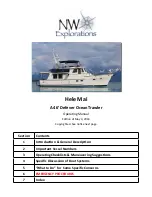
5.
Personal Flotation Device and Helmet.
The wearing
of an approved PFD is highly recommended for all
kayakers, even those who are strong swimmers. A
helmet should be worn for whitewater or surf zone
paddling.
6.
Safety Equipment.
The safety equipment you will
carry in and on your kayak will vary with the nature
and length of the trip. Kayak trips of any duration
however, require a pump, spare paddle, bouyant
heaving line, flares and whistle as essential items.
Safety equipment will only be of use to you if you
have the knowledge and training to use the equip-
ment in an emergency.
7.
Self-Rescue and Group Rescue.
The nature of kayak-
ing is such that some day you or a member of your
group will capsize. This experience can vary from
a refreshing dip in the ocean to a life-threatening
emergency. How you handle a capsize will depend
entirely on your training and experience.
The kayaking community is blessed with a wealth of materi-
al, including books, manuals, magazines, articles and videos,
and resources including schools, clubs, associations and
training centres dedicated to kayaking safety. As with any
skill, kayaking safety must first be learned and then prac-
ticed. We at Feathercraft strongly recommend that you
access resources for kayak safety in your community before
venturing out onto the water.
For more information on kayaking safety, please contact your
local kayak dealer, or your kayak or canoe association. These
websites will get you started.
University of Sea Kayaking
f
www.useakayak.org
Trade Association of Paddlesports
f
www.gopaddle.org
Sea Kayaker Magazine
f
www.seakayakermag.com
airline
gemini
2
Gemini_English 9/4/07 10:45 AM Page 2





































